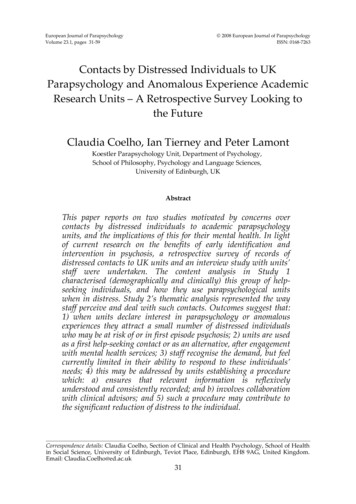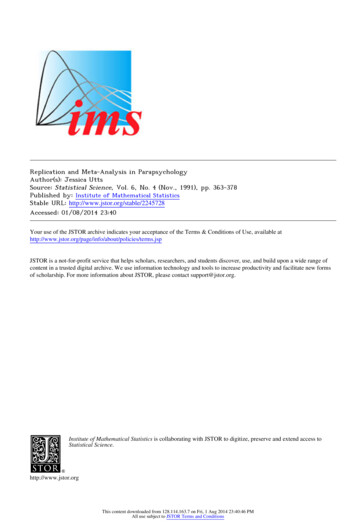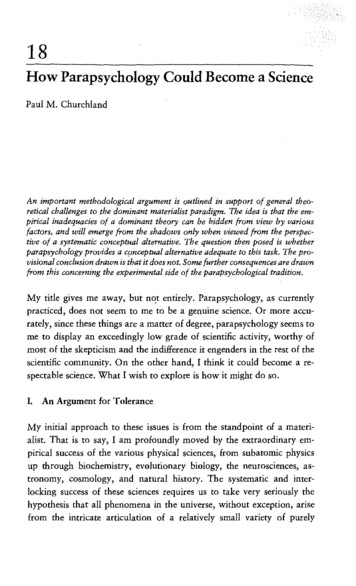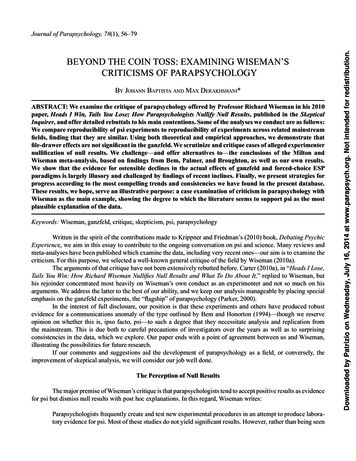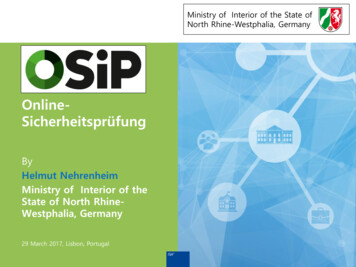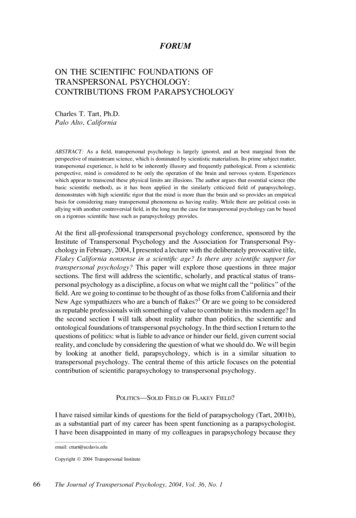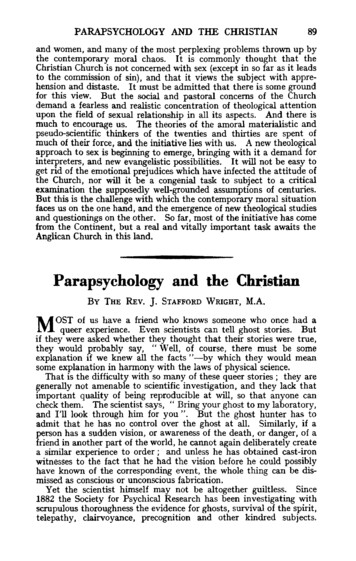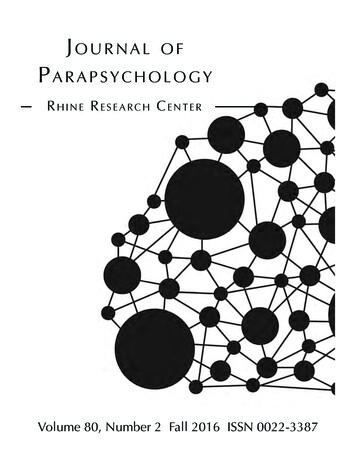
Transcription
JOURNALOFPARAPSYCHOLOGYRHINE RESEARCH CENTERVolume 80, Number 2 Fall 2016 ISSN 0022-3387
EDITORIAL STAFFJohn A. Palmer, EditorDavid Roberts, Managing EditorDonald S. Burdick, Statistical EditorRobert Gebelein, Business ManagerThe Journal of Parapsychology is published twice a year, in Spring and Fall, by Parapsychology Press,a subsidiary of The Rhine Center, 2741 Campus Walk Ave., Building 500, Durham, NC 27705. The Journal isdevoted mainly to original reports of experimental research in parapsychology. It also publishes research reviews,methodological, theoretical, and historical papers of relevance to psi research, abstracts and selected invitedaddresses from Parapsychological Association conventions, book reviews, and letters.An electronic version of the Journal is available to all subscribers on the Rhine Research Center’s website(www.rhine.org.) The current subscription rates are: Individuals ( 65.00), institutions ( 77.00), with no othercategories available. Members of the Rhine Research Center in the Scientific Supporter category receive theelectronic journal free with their membership. The current subscription rates for paper copies of the Journal are:Individuals ( 100.00), institutions ( 118.00). Foreign subscribers must pay in U.S. dollars. Selected single issues(current or archival) are available at 35.00 each; go to www.rhine.org for more information. Orders for subscriptions or back issues, correspondence, and changes of address should be sent to: Journal of Parapsychology, 2741Campus Walk Ave., Building 500, Durham, NC 27705. Subscriptions may also be ordered online at www.rhine.org.Postmaster: Send address changes to the Journal of Parapsychology, 2741 Campus Walk Ave., Building500, Durham, NC 27705. Subscribers: Send change of address notice 30 days prior to the actual change of address.The Journal will not replace undelivered copies resulting from address changes; copies will be forwarded onlyif subscribers notify their local post office in writing that they will guarantee second-class forwarding postage.Copies of this publication are available in 16-mm microfilm, 35-mm microfilm, 105-mm microfiche,article copies, and on compact disc from ProQuest, 789 E. Eisenhower Pkwy., P. O. Box 1346, Ann Arbor, MI48106-1346. Photocopies of individual articles may be obtained from The Genuine Article, ISI, 65 E. WackerPlace, Suite 400, Chicago, IL 60601. Some articles are also available through Info Trac OneFile and Lexscien.Copyright and permission. Authorization to photocopy items for internal or personal use, or the internalor personal use of specific clients, is granted by Parapsychology Press, provided that the base fee is paid directlyto Copyright Clearance Center, 222 Rosewood Dr., Danvers, MA 01923. For those organizations that have beengranted a photocopy license by CCC, a separate system of payment has been arranged.The Journal is an affiliated publication of the Parapsychological Association.Copyright 2016 by the Parapsychology PressISSN 0022-3387
Volume 80 / Number 2 / Fall 2016EDITORIALStatistical Issues in Parapsychology: Hypothesis Testing—Plus an Addendum on Bierman et al. (2016)John Palmer141PARAPSYCHOLOGICAL ASSOCIATIONPRESIDENTIAL ADDRESSAs It Occurred to Me: Lessons Learned in ResearchingParapsychological ClaimsChris A. Roe144ARTICLEIs the Methodological Revolution in ParapsychologyOver or Just Beginning?J. E. Kennedy156SPECIAL BOOK REVIEW SECTION: DO WE SURVIVEDEATH? A PHILOSOPHICAL EXAMINATIONIntroductionJohn Palmer169PART I: BEYOND PHYSICALISMThe Elusiveness of Souls: An Essay Review of BeyondPhysicalismDouglas M. Stokes169Brief Reply to Doug Stokes (and MoA)Edward F. Kelly185Reply to Ed KellyDoug Stokes188
PART II: THE MYTH OF AN AFTERLIFEThe Myth of Mortality: Comments on Martin andAugustine’s The Myth of an AfterlifeJames G. Matlock190Evidence or Prejudice? A Reply to MatlockKeith Augustine203Response to MatlockClaus F. Larsen231Replying to MatlockIngrid Hansen Smythe232Whose Prejudice? A Reply to Augustine, Smythe,and LarsenJames G. Matlock235PART III: DISCUSSIONSurvival and the Mind-Body ProblemJohn Palmer251Correspondence (Stokes, Kennedy, Butler)265Announcement: Change of Editor271Benefactors272Index273Postal Forms279Instructions for Authors282We would like to thank the following persons for theirwork in translating the abstract for this issue of theJournal: Eberhard Bauer (German), Etzel Cardeña (Spanish),and Renaud Evrard (French).
Journal of Parapsychology, 80(2), 141–143EDITORIALSTATISTICAL ISSUES IN PARAPSYCHOLOGY: HYPOTHESISTESTING—PLUS AN ADDENDUM ON BIERMAN ET AL. (2016)By John PalmerHypothesis TestingIn a previous editorial I described and defended my heretical views on how multiple analyses ofempirical results should be addressed (Palmer, 2013). In this editorial, I express and defend equally heretical views on hypothesis testing. The issue of how hypotheses should be evaluated statistically is importantfor two reasons. First, confirmation of a hypothesis goes beyond confirmation of the effect itself because itsupports, or at least should support, a theory or model. Second, a more lenient criterion of statistical significance is commonly applied to hypothesized effects than to other effects, which are often labeled “post hoc.”I have heretical proposals regarding both of these observations.A tagline for my first proposal is that what is important is not whether an outcome is hypothesizedbut whether it is hypothesizeable. There are two key circumstances where there is a mismatch between thetwo. The first is: An outcome is hypothesized that should not have been hypothesized (i.e., is not hypothesizeable). The fact that hypothesis tests are supposed to be tests of a theory or model implies that the authorhas an obligation to show how the hypothesis follows from the theory and/or previous empirical resultsrelated to the theory. In fact, this is one of the major purposes of the introduction section of a researchreport. This prescription is expressed as follows in the Publication Manual of the American PsychologicalAssociation (2010): “In empirical studies, [explaining your approach to solving a problem] usually involvesstating your hypotheses or specific questions and describing how these are logically connected to previousdata and argumentation” (p. 28; my emphasis). The word “argumentation” leads me to point out that thetheory or model need not meet the formal requirements of such; any coherent and plausible conceptualscheme that fulfills this role should suffice. On the other hand, “hypotheses” that are ad hoc or based onhunches should simply be outlawed.The second circumstance is the converse of the first: The outcome is not hypothesized but shouldhave been hypothesized (i.e., is hypothesizeable). I am sure that most researchers have had the experienceof trying to interpret a significant post hoc effect and in the process of doing so realize that there was asound basis for hypothesizing the effect. (The hypothesis would be the generalized form of a predictionof the effect.) However, I am equally sure that most parapsychologists would not retrospectively changethe status of the effect from post hoc to hypothesized (and reap the rewards of doing so) because it lookslike cheating. This is a powerful illusion, but an illusion nonetheless. As I noted above, the purpose of ahypothesis test is to provide evidence for or against a theory or model, but to fulfill that role, and for thepurported hypothesis to legitimately be designated as such, the relevance of the hypothesis to the theorymust have been established. If a proposition meets this test, a full interpretation of the effect requires thatit be identified as a hypothesis; otherwise, the support that the confirmation of the hypothesis provides forthe theory is obscured. Of course, it is the responsibility of the researcher to justify the reclassification inthe Discussion section of the report, and referees can decide whether the author has succeeded. On the otherhand, the argument against reclassification is based on the premise that a hypothesizeable effect shouldonly be hypothesized if the researcher was astute enough to recognize that it was hypothesizeable beforethe study was conducted. This is clearly nonsensical. So my first heretical proposition is that demonstrablyhypothesizeable post hoc effects not only can be , but should be, retrospectively reclassified as hypothesizedif the researcher becomes aware of its hypothesizeability.
142The Journal of ParapsychologyThe practical consequences of adhering to my first heretical proposal is markedly reduced by adherence to my second. A major reason why a researcher would want a proposition to be classified as a hypothesis is that the criteria that the prediction(s) derived from it must meet for statistical significance to beclaimed are more generous. There are generally two such criteria: (a) a one-tailed rather than a two-tailedsignificance test, and (b) waiving of the requirement for replication or a multiple-analysis correction. Myproposal is that the significance criteria for a hypothesis test should be the same as for a post hoc test, namely, a two-tailed test and a multiple analysis correction or replication.I have two arguments for my proposal. First, to confirm a hypothesis, a significant effect must beshown to be “real,” and this latter determination should be made irrespective of whether the higher-levelproposition is classified as a hypothesis. To do otherwise is to assume what is at issue: that is, that classification of the proposition as a hypothesis is proper.My second argument is similar to my objections to the use of Bayesian statistics, which I presentedin a previous editorial (Palmer, 2011). What Bayesian statistics essentially does is to allow a more liberalcriterion to be applied in assessing whether an effect is real if it can be shown that the effect has a higha priori probability of being real. In practice, the a priori probability is usually at least partly determinedby whether the overarching theory or hypothesis is consistent with the “established” theory of relevance.Of course, this is the very standard that psi doesn’t meet, and, as I argued in the editorial, there are solidgrounds for maintaining that a priori probabilities, including those based on theory, should have no influence whatsoever on how we determine the reality of an effect, and therefore, we shouldn’t use analysismethods that presuppose that the influence should be something other than zero. The case of hypothesistesting is similar, in that an effect is given an easier path to confirmation if the confirmation is consistentwith the theory that the hypothesis is derived from.The one exception to my proscription of one-tailed tests is when the “hypothesis” to be tested is areplication of a previous finding. The reason is that a significant effect in the opposite direction cancels outthe original result leading to the conclusion that the effect is not real, the same conclusion one would drawif the replication outcome were nonsignificant. This is not the case for other hypothesis tests. I also maintainthat replications are the only hypothesis tests that should be considered “confirmatory” in the sense thisterm is used by Kennedy (2016).One-tailed tests are also appropriate for meta-analyses, at least insofar as they be can be construedas a test of the replicability of a previous finding or set of findings, which I think is almost always the case inpractice. I agree with Kennedy (2016) that they should be “prospective.” A particularly important questionin this connection is how close the methodology of the replication needs to be to that of the original studyto qualify for inclusion in the meta-analysis, and how uniform in methodology the original studies need tobe for them to qualify as targets. I take a more liberal view on this matter than I believe Kennedy does, but Idon’t have an argument for this preference. However, evidence from the meta-analysis of Bem, Palmer, andBroughton (2001) that only studies that closely followed the methodology of the PRL autoganzfeld serieswere collectively significant suggests that a more conservative approach might be a better tactic. Finally, Ishould note my reservations with using the Stouffer Z as a measure of replication (Palmer, 2013).Bierman et al. (2016)Bierman chose not to reply to my editorial in the last issue of the JP (Palmer, 2016) with a Letterto the Editor but he did reply to me privately (D. Bierman, personal communication, August 4, 2016). Hemakes some dubious statements in that letter that suggest to me I need to expand on a main point of theeditorial, especially because he is likely to circulate these statements privately.The key point in Bierman’s letter to me is that Bierman, Spottiswoode, and Bijl (BSB; 2016) werenot making any claims about whether QRPs in fact existed in the database. Instead the purpose of the analysis was to say what the effect on the significance of the database would be if one were to assume a certainpercentage of QRP studies in the database. As he expressed it: “Our conclusion was that assuming thatparapsychologists did behave like main stream colleagues we could ‘explain’ a large fraction of the effect
Editorial143size reported in that particular meta-analysis. Our conclusion was not a) the parapsychologists are as bad asthe main stream experimenters (that was an assumption); b) experimenter X used QRP Y.” In other words,it’s all hypothetical.If that’s all it is, the whole exercise was a monumental waste of time (and journal space), but thewhole point of my editorial was to demonstrate why this is not in fact the case. I would like to add a few additional observations. First, Bierman’s assertion that his conclusion is strictly hypothetical is clearly refutedin the abstract of the BSB paper: “We conclude that the very significant probability cited by the Ganzfeldmeta-analysis is likely inflated by QRPs, though results are still significant (p 0.003) with QRPs” (Bierman et al., 2016). This does not describe a hypothetical, “what if” situation. Albeit it refers to a likelihood,but the likelihood is of something real.Second, it’s very telling that in their article BSB never explicitly deny insinuating that there actually were a nontrivial numbers of fraudulent QRPs in the database and that QRPs were committed inparticular studies. They would have to be imbeciles not to recognize that such inferences by the reader arepossible (even likely), and given the seriousness of the potential charges, if their motives really were benignthey would have bent over backwards to make this denial clear to the reader.Bierman’s claim in his letter that “Our conclusion was not . . . experimenter X used QRP Y” is alsoproblematic. It is explicit in their subsection on fraud that two particular studies were chosen for the QRPdesignation, to the point that with the aid of their disappearing supplement file I was able to identify whothe author was. All a reader has to do to identify which authors committed a misclassification QRP (e.g.,optional stopping or extension) is check the ganzfeld literature for studies with nonround Ns. Of course,Bierman is correct that none of these attributions were “conclusions.” They instead were insinuations, andas I noted in the previous editorial, in my mind insinuations are worse than flat-out allegations. Indeed, thiswas the basis of my comparing the BSB article to the writings of Hansel.It is important to recognize that the fraud insinuations do not generally appear in the description ofthe meta-analysis per se or of its results. For instance, the unjustified inference of misclassification from anonround sample size informed only the estimate of the proportion of studies in which that QRP occurred.BSB try (unsuccessfully) to justify this inference by pointing out that that the percentage of nonround studies in the ganzfeld database is similar to the estimate obtained by John, Lowenstein, and Prelec (2012) formisclassification QRPs in psychology experiments.Finally, it should be noted that the BSB paper was published in a psychology journal rather than aparapsychology journal, which means that its target audience was mainstream psychologists. I don’t need acrystal ball to tell me that these readers reached the conclusion expressed in the abstract, which I suspectis as far as many of them (and especially the media) went.ReferencesAmerican Psychological Association (2010). Publication manual of the American Psychological Association (6th ed.).Washington, DC: Author.Bem, D. J., Palmer, J., & Broughton, R. S. (2001). Updating the ganzfeld database: A victim of its own success? Journal of Parapsychology, 65, 207–218.Bierman, D. J, Spottiswoode, J. P., & Bijl, A. (2016, May 4). Testing for questionable research practices in a meta-analysis: An example from experimental parapsychology. PLOS ONE. Retrieved from http://journals.plos.org/plosone/article?id 10.1371/journal.pone.0153049John, L. K., Loewenstein, G., & Prelec, D. (2012). Measuring the prevalence of questionable research practices withincentives for truth telling. Psychological Science, 23, 524–532.Kennedy, J. E. (2016). Is the methodological revolution in psychology over or just beginning? Journal of Parapsychology, 80, 156–168.Palmer, J. (2011). On Bem and Bayes [Editorial]. Journal of Parapsychology, 75, 179–184.Palmer, J. (2013). JP publication policy: Statistical issues [Editorial]. Journal of Parapsychology, 77, 5–8.Palmer, J. (2016). Hansel’s ghost: Resurrection of the experimenter fraud hypothesis in parapsychology [Editorial].Journal of Parapsychology, 80, 5–16.
Journal of Parapsychology, 80(2), 144–155AS IT OCCURRED TO ME: LESSONS LEARNED INRESEARCHING PARAPSYCHOLOGICAL CLAIMS1By Chris A. RoeIntroductionI have been involved in parapsychology for a little over 25 years (including my time as a PhD student),so in preparing this paper I’ve welcomed the opportunity to reflect on that experience to see if any of it isworth sharing with the wider community. In particular, I wondered if there were lessons I have learned thehard way that could be of benefit to early career researchers, so that their trajectory might be a little moresmooth or fruitful than my own has been. I have selected some things that have occurred to me both in thesense of events that have happened and in the sense of realisations I have had based on those experiences. Ihope they represent useful insights into what I regard as the art of scientific practice in parapsychology. Theyhave shaped the kind of researcher I have become and perhaps explain some of my preoccupations and biases.Early BeginningsMy first love is the scientific method. I first became interested in parapsychology when aged about14, not through any powerful or vivid personal experience, or through a family history of paranormal beliefsor practices, but by discovering scientific research on the subject. In the UK a magazine was publishedcalled The Unexplained that promised to explore all sorts of fantastical phenomena, from alien visitationsto spontaneous human combustion, and these unsurprisingly were very attractive to a young teenager witha fairly rich imagination but also a skeptical disposition. These tales were sobering in reminding us howmuch there is still to learn about nature and the phenomena that it permits. However, I quickly becamedisillusioned by a tendency for reports of investigations to end with the conclusion that the phenomenonremained a mystery, rather proudly declaring that things were inexplicable in terms of current scientificprinciples, and so cocking a snook at the hubris of the scientific mainstream by demonstrating that it didn’t,in fact, know everything, but adding very little to what we did know. Surely demonstrating an anomalywas the beginning of the scientist’s story rather than the end of it, indicating as it did the most potentiallyrewarding or revealing areas for future investigation? Thankfully, other articles in the magazine were moremeasured in tone, particularly, I recall, those highlighting Ed Cox’s minilab experiments and Carl Sargent’sganzfeld studies at Cambridge,2 and these adhered to more recognizably scientific methods that might besuperficially less exciting, making slower progress and reporting only modest gains, but ultimately be moresatisfying in providing trustworthy accounts of how things really are. And so, aged 14, I determined tobecome a parapsychologist—how difficult could that be?Three years later, in 1984, I needed to decide to which universities I would apply. I had a meetingwith my school careers adviser and mentioned my interest in parapsychology, and he remarked that hehad just seen a press release about the appointment of a new Professor of Parapsychology at EdinburghUniversity. I can recognise an omen when I see one, and so it was that I applied to study psychology atEdinburgh. My original application to study for a Bachelor of Arts degree was returned to me, with theadmissions tutor recommending that if I wanted to become a parapsychologist then I would be better totake a Bachelor of Science pathway, with its greater emphasis on training in experimental work. This waseffectively a biological sciences degree with a major in psychology, so that I continued to study physics,chemistry and biology (my A-level subjects) alongside zoology and psychology.A version of this paper was presented at the Parapsychological Association 35th annual convention, Boulder Colorado,June 19–24, 2016.2See, for example, Cox (1984) and Sargent (1980), but also Hansen (1985).1
Lessons Learned in Researching Parapsychological Claims145The Sociology of ScienceSo it was that my education to that point was wholly in the natural sciences and had turned me intoa philosophically naive positivist researcher—I had been taught that the scientific method was simply aprocess of disciplined observation that guarded against what Francis Bacon (1620/2015) called idols (of theTribe, the Cave, the Marketplace, and the Theatre); that is, the ways in which we might deceive ourselveswhen making observations and when drawing inferences from those observations. From that perspective,nature might seem inscrutable, but it would give up its secrets with appropriate effort and diligence on mypart. Science, I thought, is a process of increasing refinement and exactitude, particularly in measurement,and all meaningful properties of the world can be measured objectively and consistently if we are carefulenough. I was soon to discover the limits of this philosophy when I came to conduct my own research.I had a foretaste of things to come when I included in my undergraduate programme moduleson the philosophy and sociology of science with members of Edinburgh’s influential Science StudiesUnit. Scholars such as Barry Barnes, Steve Shapin and David Bloor3 had a huge influence on me. I wasintroduced to the notion that even in the natural sciences scientific knowledge can be a function of its socialand political time, that the scientific elite is inherently conservative and suppressive, and that, in ThomasKuhn’s (1970) terms, scientific practice is only rarely edging toward revolution and is more commonlyengaged in “normal science” with its concomitant aggressive policing of the border between the legitimateand the illegitimate. The work of some of these philosophers and sociologists shows that, for most of themainstream, parapsychology lies on the wrong side of that border, and is a victim of those processes (e.g.,Collins, 1985; Collins & Pinch, 1983; Wallis, 1979).This perspective informed my undergraduate dissertation project, which looked at how the qualityratings of the methodology of a parapsychology research paper (intended to simulate the journal reviewprocess) depends not on the described method itself but on whether the outcome and conclusions arecongruent or incongruent with the assessor’s own prior beliefs. In a classical instance of cognitive dissonance,participants were able to relieve tension brought about by being confronted with counter evidence by simplydismissing the evidence as invalid. I replicated the effect with students from St Andrews University andpublished the results in the British Journal of Psychology (Roe, 1999)—still my only publication in theflagship journal of the British Psychological Society.This work drove home to me the extent to which people use their rational faculties for post factojustification rather than for genuine decision making, and it made the Jonathan Swift quotation4 “It isuseless to attempt to reason a man out of a thing he was never reasoned into” one of my reference points.In my election statement for PA President I mentioned that I thought we spent too much time and energyengaging with sceptics whose reputations are too strongly associated with the counteradvocate positionfor there to be any realistic prospect of a shift in their public pronouncements, whatever the quality ofmethods or data we present. It is interesting to note, for example, that the substantive arguments offered byRay Hyman (2010) and James Alcock (2010) in Krippner and Friedman’s edited book, Debating PsychicExperience, are essentially the same as those they offered 20 years earlier in books such as The ElusiveQuarry and Science and Supernature, respectively (Alcock, 1990; Hyman, 1989). That intransigence inthe face of quite significant shifts in the methods and evidence base of parapsychology suggests—to me,at least—a preference for rhetoric over genuine engagement with the field. It seems that little has changedsince Charles Honorton’s (1993) damning critique of “the impoverished state of scepticism,” which remainsthe most incisive criticism of the counteradvocate position.I am not recommending that we ignore our sceptical colleagues but that we are clear in what weare aiming to achieve when we do respond to them. For example, in 2010 I wrote a rejoinder for TheSkeptic Magazine to an article by Ray Hyman in which he asked the leading question “is Parapsychologydead or alive?” and I have appeared regularly with Chris French in the UK to discuss parapsychologicalclaims before public audiences. One such event, a panel debate that also included Richard Wiseman onFor examples of their approach, see Barnes (1985), Barnes, Bloor, and Henry (1996), and Shapin (1996).Attributed to Swift in Scientific American, Vol. 7 (Munn & Company, 1851), p. 338, but disputed and possiblyapocryphal.34
146The Journal of Parapsychologythe apparent crisis in psychology and parapsychology at the UK skeptics’ conference was attended byperhaps twice as many people as attended the joint meeting of the Parapsychological Association andSociety for Scientific Exploration in 2016. My objective in each of these encounters was not, of course, tofacilitate a shift in the sceptic’s position, but to speak through them to a broader audience, some of whoseopinions hopefully had not yet ossified, providing them with a more balanced picture of parapsychology’sdiscoveries and emphasising that its practice was scientific “business as usual.” Given the virulent way inwhich the Wikipedia entries on parapsychology are mismanaged, we have a difficult but important taskahead in ensuring that interested but discriminating members of the public can get access to accurate andbalanced information about the state of the field.Considering Normal ExplanationsAfter my undergraduate degree I went on to study for a PhD at the Koestler Parapsychology Unit,and my research topic reflected the unit’s emphasis on crossdisciplinary approaches, and on determining“what looks psychic but isn’t” in order to better understand the processes that can lead to an attribution ofparanormality. I explored the technique of cold reading by getting access to a set of arcane publications thatrepresent how-to guides for would-be pseudopsychics and by spending time with a practitioner who hadbeen working the circuit for over 30 years. Malcolm5 agreed to give readings to people he had never metbefore. The clients were asked to rate the accuracy of the readings and to make a judgement as to whetherwe should study him further, in more formal research. Two of the three sitters were very impressed bytheir readings and gave unequivocal recommendations. We videotaped the interactions and then recordedMalcolm as he watched the video and explained the stratagems he had been applying.In analysing Malcolm’s account and synthesising the descriptions from cold reading manuals, itbecame obvious to me that the technique was actually a set of techniques that varied according to howmuch information leakage was required from the client and how specific the reading material could be:the more leakage, the greater the specificity (see Roe, 1991; Roe & Roxburgh, 2013a, 2013b). This modelargues strongly against the “heads I win, tails you lose” explanation offered by some sceptics, wherebyunimpressive readings from mediums and psychics provide evidence that psi does not occur, whereasimpressive readings from mediums and psychics are seen as evidence of the widespread use of cold readingand so also show that psi does not occur. The intention of the work was to show that we need to takeinto account the prevailing conditions when assessing whether communications of the specificity observedcould be achieved through cold reading alone. It’s interesting to note here that explanations in terms of coldreading make some assumptions about client behaviour, including their tendency to recall only the hits andforget the misses, and to elaborate on given material in ways that make the recalled version more specificto them; surprisingly, the only attempts to test these assumptions that I am aware of have been conductedby me (Roe, 1994)—rather than seeking experimental evidence for cold reading, sceptical researchers havebeen content to apply the method afte
The Journal of Parapsychology is published twice a year, in Spring and Fall, by Parapsychology Press, a subsidiary of The Rhine Center, 2741 Campus Walk Ave., Building 500, Durham, NC 27705. The Journal is devoted mainly to original reports of experimental research in parapsychology. It also publishes research reviews,
